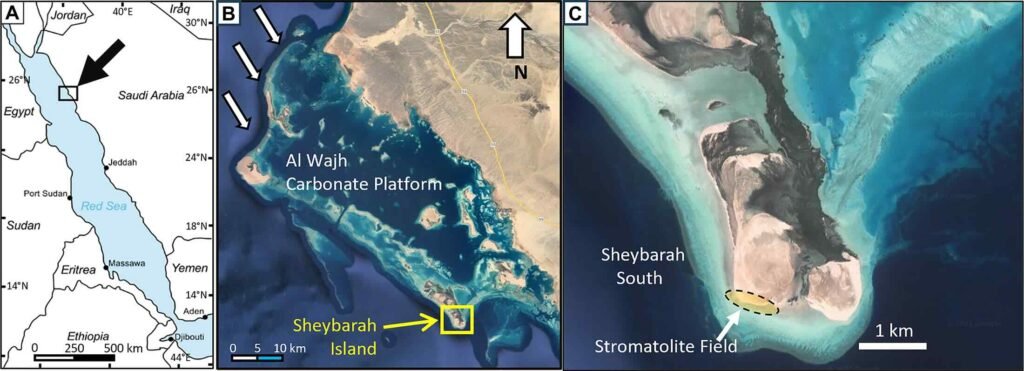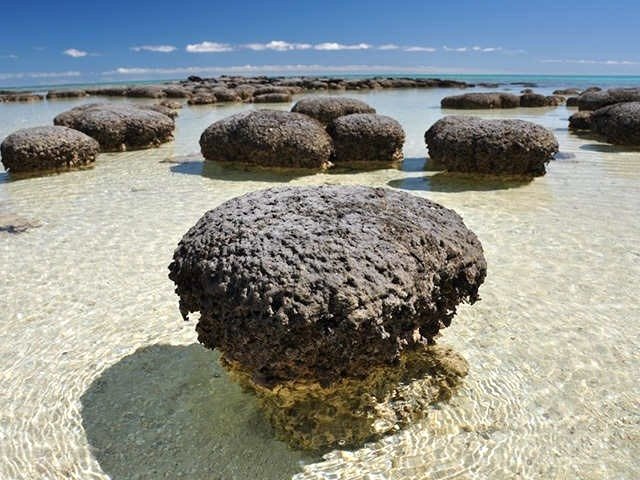Scientists have identified living stromatolites on Saudi Arabia’s Sheybarah Island in the Red Sea, marking the first discovery of living shallow-marine stromatolites in the Middle East. The discovery raises significant questions related to how and where life first originated on planet Earth.
Published in the journal Geology, the study explores these ancient microbial structures and offers a unique glimpse into Earth’s early life and the environmental conditions that prevailed billions of years ago.
Stromatolites are layered, sedimentary formations created by the activity of microorganisms, primarily cyanobacteria. These structures are among the oldest evidence of life on Earth, dating back over 3.5 billion years. The formation of stromatolites begins when cyanobacteria grow on surfaces such as rocks or sediment. As these microorganisms multiply, they trap and bind sediment particles together, forming layers of organic material and minerals. Over time, these layers build up, creating distinctive dome-shaped or columnar structures. The cyanobacteria, also known as blue-green algae, use sunlight to photosynthesize, producing oxygen and creating layers of calcium carbonate and other minerals.
More importantly, especially for life on Earth, these ancient stromatolites played a crucial role in the Great Oxygenation Event, which drastically changed Earth’s atmosphere by introducing oxygen, allowing more complex life forms to evolve.
According to the study, these newly discovered stromatolites on Sheybarah Island are located just off the southwestern tip of the island. They cover an area exceeding 5 hectares and exhibit multiple growth forms. The discovery was made by accident during a field visit in January 2021 using a local fishing boat. Later, detailed field visits and sampling were conducted to study the stromatolites. The researchers used various techniques, including drone surveys, hand sampling, and X-ray micro-computed tomography analysis, to examine their internal structures and microbial diversity.


The study reveals that the stromatolites’ growth is influenced by environmental factors such as regular wetting and drying, extreme temperature ranges, and light currents. The Sheybarah stromatolites are primarily formed by microbially mediated accretion and differential lithification of sediment grains. The microbial community within the stromatolites is dominated by filamentous cyanobacteria, which form mucous sheaths and extracellular polymeric substances. These living structures are incredibly diverse and have formed very slowly, but their true age remains a mystery.
“To the best of our knowledge, the discovery of the Sheybarah stromatolites is the first of its kind in the Middle East, presenting an unprecedented opportunity to study their geobiology in this unique geographic region,” the study authors wrote. “Modern open shallow-marine stromatolites are sparsely present on the planet, leading to a lack of suitable analogues for their ancient counterparts.”
The discovery of living stromatolites on Sheybarah Island provides a unique opportunity to study early life and ocean evolution on Earth. These structures are analogous to the stromatolites that dominated the planet during the Archean and Proterozoic eras. Understanding the formation and growth of modern stromatolites can offer insights into the conditions that prevailed on early Earth and the processes that led to the development of complex life forms.
Moreover, the study of stromatolites has implications for the search for extraterrestrial life. Stromatolites are considered potential biosignatures for life on other planets, such as Mars. By studying the microbial communities and environmental conditions that support stromatolite formation on Earth, scientists can develop models to recognize potential signs of life on other planets.
A PDF version of the study can be downloaded here.
MJ Banias covers space, security, and technology with The Debrief. You can email him at mj@thedebrief.org or follow him on Twitter @mjbanias.

